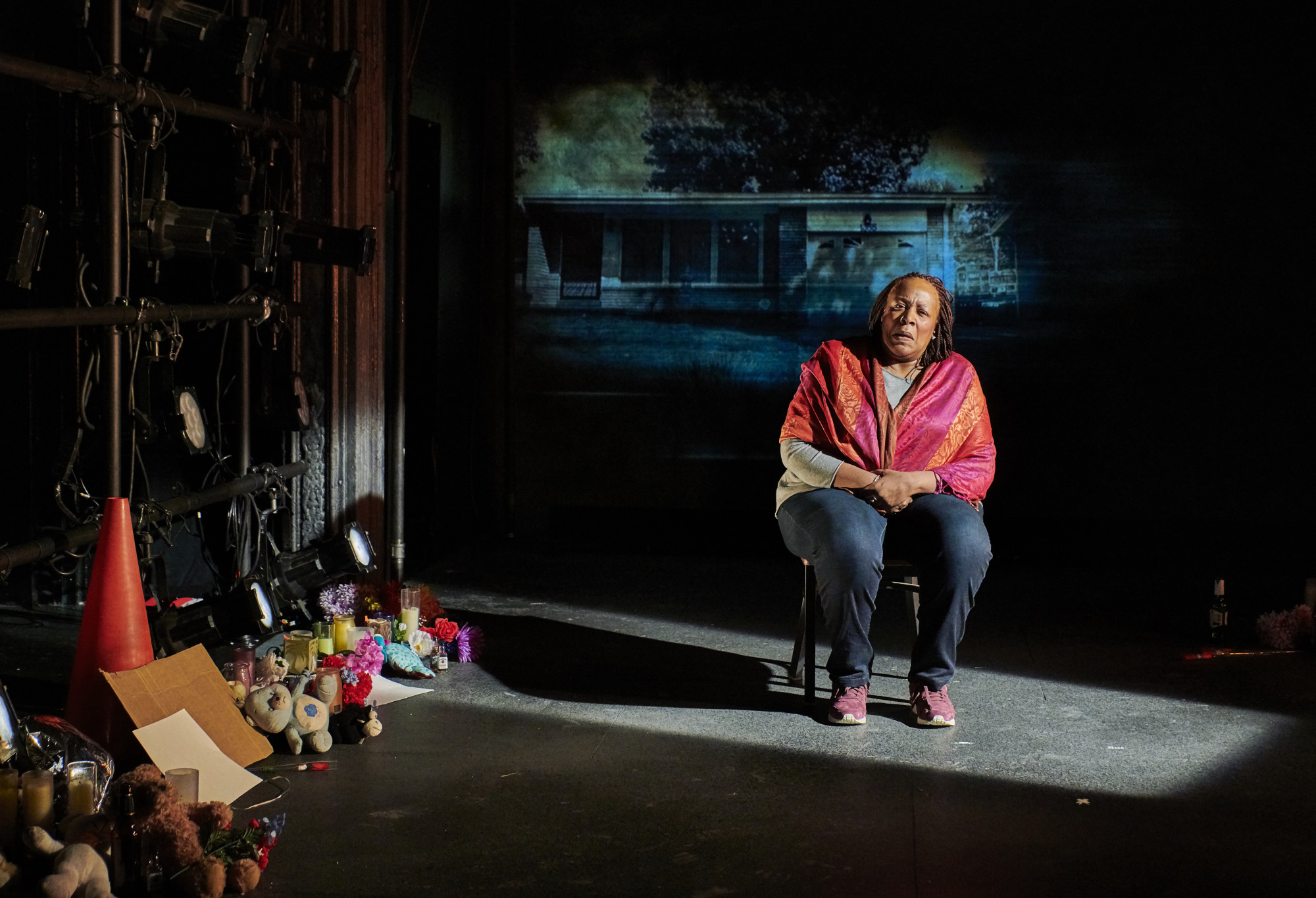Mourning, Minimalism & Motion
Scenic Designer Takeshi Kata Discusses the Collaborations and Real-Life Inspirations that Shaped His Design of ‘Until the Flood’

The set of Pulitzer Prize finalist Dael Orlandersmith’s Until the Flood transports audiences back to the late summer of 2014, when Ferguson, Missouri boiled with unrest after teenager Michael Brown was fatally shot by police officer Darren Wilson. In the aftermath of the incident, the town’s grief was palpable, and on the pavement where Brown died, hundreds left tokens of compassion: stuffed animals, vivid bouquets, handmade posters, and prayer candles. From January 24 – February 23, 2020, Brown’s death is remembered via such symbolism once again—this time at the Kirk Douglas Theatre. Seamlessly re-visualizing the compassion of Ferguson’s residents is the show’s set, executed by scenic designer Takeshi Kata.
“We wanted to capture the emotional conflict that the community was feeling, but we also wanted to create a clean visual for the audience,” said Kata. “So the set design is a gentler, more ritualistic reincarnation of the memorials that were actually in Ferguson.” Indeed, despite the play’s tumultuous subject matter, audiences will notice that there is a certain quietude in its scenic design. Surrounding the intimate stage are keepsakes seemingly pulled from the Ferguson memorials themselves. Yet, most of the stage is empty, leaving enough room for Orlandersmith’s poetics to remain in focus—an intentional decision by Kata, who also designed the scenery for Forever, Orlandersmith’s semi-autobiographical solo show that appeared at the Douglas in 2014. “In a way, a significant part of my role is to get out of the way, to let Dael and her language fill up the space—it’s important to allow the audience to imagine the story themselves,” he said.
“Tak is an incredible set designer and wonderful collaborator—he consistently investigates the play thoroughly, and has a narrative acumen that always helps me better understand and articulate the core story behind a play,” said Until the Flood and Forever director Neel Keller, who is also Associate Artistic Director/Literary Director at Center Theatre Group. For Orlandersmith’s latest solo show—a performance inspired by the indignation and empathy surrounding a real-life event—Kata’s understanding is especially necessary.
In both Forever and Until the Flood, Kata’s set design features a sparse stage with few props: a wooden table here, a chair or two there. This minimalist approach reflects his aesthetic preference, a style that originated in his decades of work with the American Players Theatre, an outdoor amphitheater setting with little room to accommodate ornate scenery. However, he noted that for a show like Until the Flood—in which the performer, rather than a set, is mostly guiding the audience—the idea of stripped-back design was also an obstacle. “Because the set is so minimal, everything had to be placed with precision,” Kata said. “So a big challenge was finding the best place for Dael to be, in terms of her relationship with the audience.”
Keller compares Kata’s natural understanding of space to an architect’s feel for geometry and mass: “His designs always respond to the particular theatre space we’re working in to create a sense of magic on each stage.”
His designs always respond to the particular theatre space we’re working in to create a sense of magic on each stage.
From start to finish, Until the Flood glistens with plenty of visual stimuli—aside from Orlandersmith’s lyrical language and movement, complementing the production’s minimalist set are the arresting graphics that appear behind the actor. Projection designer Nicholas Hussong’s vibrant, textured images—the digital artifacts of his journeying to and photographing of different St. Louis neighborhoods in 2016—are cast upon a large canvas backdrop with a subtle, smoke-like detail symbolizing the tear gas used by police during the Ferguson protests. Kata recalled that Hussong was particularly inspired by the way St. Louis—located just 12 miles north of Ferguson—consists of disjointed, informally segregated neighborhoods. “Each area in the city has its own unique dynamic, and Nicholas wanted the projection to represent motion—the idea of moving from one place in St. Louis to another,” said Kata.
Orlandersmith’s composite characters inspired by St. Louis residents—each taking up their own space on the broad spectrum of privilege and on the stage—also capture the feeling of motion, along with their varying personal convictions surrounding the killing of Michael Brown. For Kata, watching these composites awaken on stage is the best part of working with Orlandersmith. “She’s such a strong performer and collaborator—she knows what she wants, but is always open to new ideas,” he said. “When you see her performing these characters, it’s almost like they’re coming through her—she’s conjuring them, in a way. So each time you see her on the stage, it’s like being introduced to a new person, and that’s so enthralling.”

